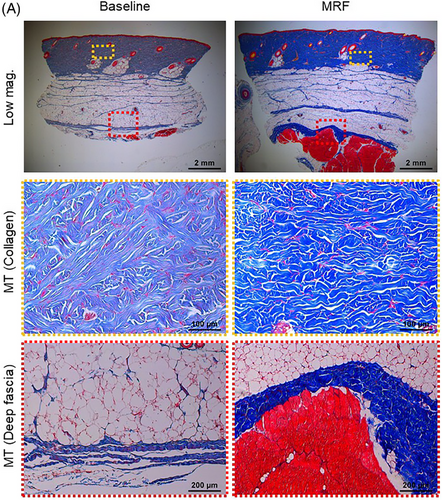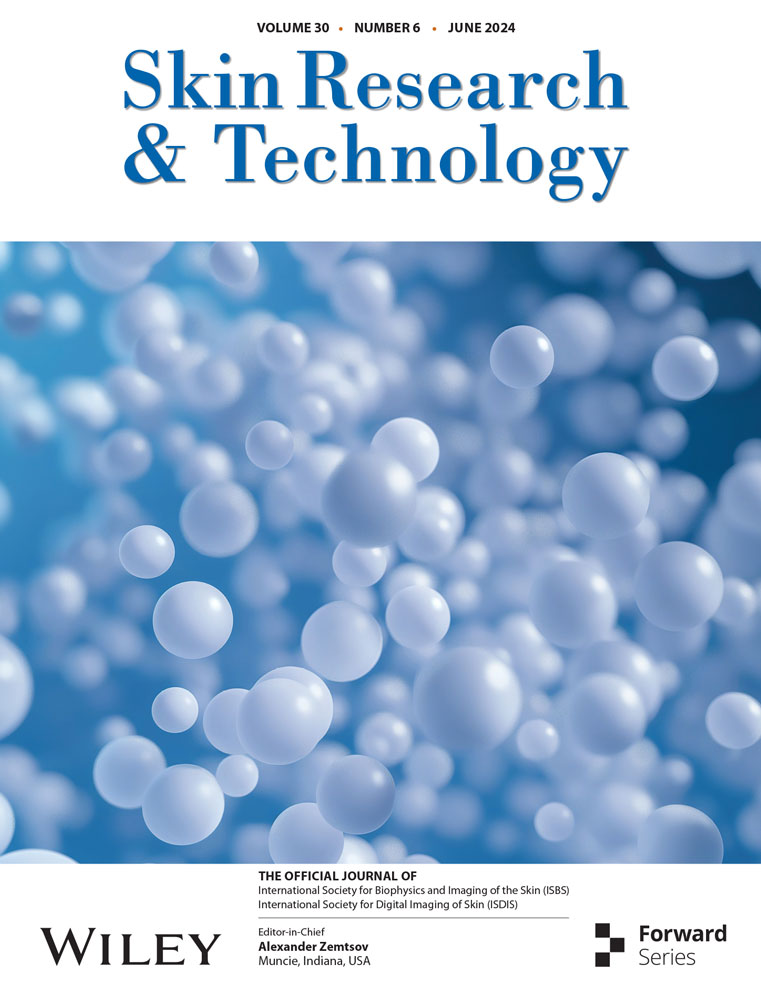Efficacy of dual-frequency noninvasive monopolar radiofrequency in skin tightening: Histological evidence
Jumi Hong and Hye Guk Ryu contributed equally to this work.
To the Editor,
In the rapidly evolving field of dermatological therapy, exploring innovative energy-based devices presents a promising frontier for enhancing skin rejuvenation techniques.1, 2 This letter introduces significant findings from our study on the effects of a novel Noninvasive Monopolar Radiofrequency (NMRF) device, XERF, which utilizes unique dual-frequency technology at both 6.78 and 2 MHz. Our study is primarily aimed at exploring the effects of delivering thermal energy to the dermis and beyond, including the deep dermis and subcutaneous fat regions, with a focus on its impact on collagen remodeling, which is crucial for skin tightening.
NMRF technology has been a cornerstone in dermatological treatments, renowned for its efficacy in delivering heat to the dermis,3 thereby inducing immediate and long-term changes in collagen structure. While high-intensity focused ultrasound (HIFU) effectively targets deep tissues and specific focal regions,4, 5 NMRF excels in treating broader areas and is particularly adept at achieving significant skin tightening. Traditional devices, operating at 6.78 MHz and having received FDA approval for wrinkle removal over 20 years ago, are widely utilized.6 However, the precise mechanisms through which NMRF influences deeper skin layers, including the deep dermis and septa, have yet to be fully elucidated, with in vivo experimental validation still lacking. Moreover, there's a need for more empirical evidence to establish a clear link between the depth of penetration into deeper skin structures and the resulting clinical outcomes, underscoring the importance of detailed experimental investigation.
Our investigation employed a porcine model to experimentally verify the thermal penetration and effects of NMRF, focusing particularly on a novel approach utilizing a dual-frequency setting of 6.78+2 MHz. The results were compelling, with histological analysis via Masson's Trichrome (MT) stain revealing immediate alterations in collagen bundle configurations post-exposure to the 6.78+2 MHz frequency. Specifically, we observed a significant thickening and shortening of collagen bundles, indicative of immediate tissue restructuring (Figure 1, yellow dotted lines). Most notably, our findings demonstrated a marked thickening of both the superficial and deep fascial layers, a result not previously documented with traditional NMRF devices. Furthermore, an upward pull in the fascia was observed. These outcomes highlight the device's capacity to impact deeper structural components of the skin, thereby offering a mechanism by which skin tightening effects are achieved (Figure 1, red dotted lines).

The findings discussed present a range of significant implications. Firstly, the ability of the 6.78+2 MHz NMRF device to induce immediate collagen bundle restructuring and fascial layer thickening substantiates the hypothesis that lower frequencies enhance dermal penetration and therapeutic efficacy. This challenges the conventional monofrequency approach and opens avenues for further research into dual-frequency RF technologies. Moreover, the significant changes observed in both the superficial and deep fascial layers underscore the potential of this technology for comprehensive skin tightening. By affecting deeper skin structures, the 6.78+2 MHz NMRF device not only promises improvements in skin texture and elasticity but also offers a novel approach to address more profound skin concerns that were previously unattainable with traditional RF devices.
In conclusion, our study provides the first empirical evidence of the depth and efficacy of thermal delivery by NMRF technology, particularly through a novel dual-frequency approach. These findings herald a new era in dermatological treatments, emphasizing the importance of innovation in the development of energy-based devices for skin tightening. Further research is warranted to explore the long-term clinical outcomes and potential applications of this technology in dermatological practice.
ACKNOWLEDGMENTS
We thank Dr. R. Glen Calderhead for review and revise this manuscript. The author received no financial support for the research, authorship, and publication of this article.
CONFLICT OF INTERST STATEMENT
The authors have no conflict of interests to declare.
ETHICS STATEMENT
All experimental procedures were in accordance with the guidelines of Laboratory Animal Manual of National Institute of Health Guide for the Care and Use of Animals. They were approved by the Institutional Animal Care and Use Committee of CRONEX Corporation (NO. CRONEX-IACUC: 202305004).




